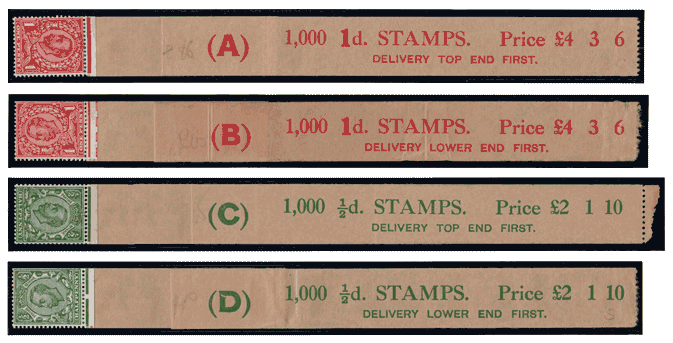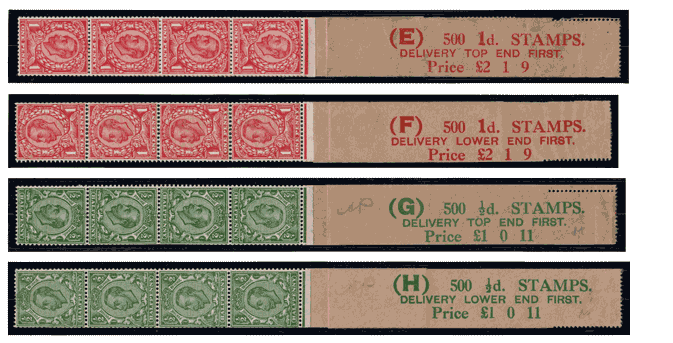
The first Post Office rolls were produced for use in stamp affixing machines in August 1912.
Outer wrappers, or leaders, show a code letter, number and denomination of stamps, method of delivery, and price of the roll which included a handling charge of 1d per 500 stamps. Initially the handling charge was proposed as 1½d for rolls of 500 stamps and 2d for rolls of 1,000 stamps but this was changed to 1d for rolls of 500 stamps before production started.
Only Die 2 stamps were used, but each of the eight code letters exist with all three watermarks: Crown, Simple Cypher, and Multiple Cypher.
| A | 1d | 1,000 | £4.3.6 | Top End | Buff | 10 |
| B | 1d | 1,000 | £4.3.6 | Lower End | Buff | 10 |
| C | ½d | 1,000 | £2.1.10 | Top End | Buff | 10 |
| D | ½d | 1,000 | £2.1.10 | Lower End | Buff | 10 |
| E | 1d | 500 | £2.1.9 | Top End | Buff | 10 |
| F | 1d | 500 | £2.1.9 | Lower End | Buff | 10 |
| G | ½d | 500 | £1.0.11 | Top End | Buff | 10 |
| H | ½d | 500 | £1.0.11 | Lower End | Buff | 10 |
Rolls (AC) were for Michelius machines (which did not do well and rolls were discontinued in 1920), rolls (BD) were for POKO machines, rolls (EG) for FIXO, and rolls (FH) for Multipost.
Rolls (ABCD) had 1,000 stamps wound lengthways, facing outwards, onto 1¼” diameter cores. Leaders were printed in two lines, without a printer’s imprint, and perforated gauge 11 at the right.

Rolls (EFGH) had 500 stamps wound lengthways, facing outwards, onto ½” diameter cores. Leaders were printed in three lines, without a printer’s imprint, and perforated 15×14 at the right.

Several of these leaders are ex C. F. Dendy Marshall and shown on Plate XII of The British Post Office.
Increased Postal Rate — 2d
The minimum Inland Letter Rate was increased from 1½d to 2d on 1 June 1920. The handling charge was also increased from 1d to 2d per 500 stamps on the same date. Downey rolls still in stock were amended in manuscript.

(B): £4.3.6 to £4.3.8 (C): £2.1.10 to £2.2.0